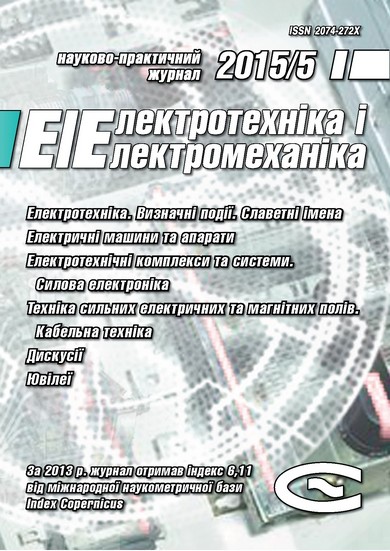CONTROL SYSTEM FOR MULTILEVEL INVERTOR OF SOLAR POWER STATION
DOI:
https://doi.org/10.20998/2074-272X.2015.5.07Keywords:
invertor, control, solar moduleAbstract
Purpose. The development of control law for network multilevel invertor of solar power station and design device for control law realization. Methodology. At synthesis of control law theory of automatic control, power network engineering and circuit technique are considered. The control law for distributive control over the direct-axis and quadrature-axis currents of invertor after abc-dq transform of three phase current’s momentary value is used. Results. The improved model of regulator of direct-axis invertor’s current is developed and provides the voltage optimization of invertor’s operating both from solar module and from network by means of calculation the reactive power consumption from network, voltage on network and voltage on solar module. The improved model of regulator of quadrature-axis invertor’s current is developed and provides the power and frequency optimization of invertor’s operating by means of calculation ratio of active power consumption and power from solar module. Originality. The offered control law and device, which realize it, is working out on secondary loop from power network smart grid with active and reactive power consumption monitoring. That provides the optimal operation of solar station both from solar module and from power network. Practical value. The proposed control law and structure of the network multilevel invertor for solar power station provide the operate mode of solar module in maximum power point and increasing the solar module’s productivity.References
Gaëtan Masson, Sinead Orlandi, Manoël Rekinger. Global market outlook for photovoltaics 2014-2018. European Photovoltaic Industry Association. Brussels, Belgium, 2014. 57 p.
Corzine K.A. Operation and design of multilevel inverters. University of Missouri: Rolla, 2005. 79 p.
Volkov A.V., Skalko Y.S. High voltage asynchronous electric drive with stand alone voltage invertor. Visnyk Kremenchutskoho derzhavnoho universytetu imeni Mykhaila Ostrohradskoho – Transactions of Kremenchuk Mykhaylo Ostrogradskiy State University, 2008, no.4(51), part 1, pp. 14-17. (Rus).
Zhemerov G.G., Tugay D.V., Titarenko I.G. Simulation of an AC drive system comprising a cascade multilevel voltage inverter. Elektrotekhnika i elektromekhanika – Electrical engineering & electromechanics, 2013, no.2, pp. 40-47. (Rus).
Ohotkin G.P., Serebrenikov A.G. Osnovnyie principy postroyeniya avtonomnyh solnechnyh electrostantsyi [The basic principles of construction of stand alone solar power station]. Sovremennyie problemy nauki i obrazovaniya – Modern problems of science and education, 2012, no.6. Available at: http://www.science-education.ru/106-7345 (Accessed 09 October 2012). (Rus).
Lezhniuk P.D., Komar V.O., Sobchuk D.S. The evaluating of influence of renewable energy source on balance reliability providing in power network. Visnyk Vinnytskogo politehnichnogo instytutu – Visnyk of Vinnytsia Politechnical Institute, 2013, no.6, pp. 45-47. (Ukr).
Ovcharenko N.I. Avtomatica energosystem [The power system’s automatic]. Moscow, Edit. house of MEI, 2009. 476 p. (Rus).
MSP432 Hardware Tools. User’s Guide. Texas Instruments, March 2015. 21 p.
Downloads
Published
How to Cite
Issue
Section
License
Copyright (c) 2015 S. M. Levitskiy

This work is licensed under a Creative Commons Attribution-NonCommercial 4.0 International License.
Authors who publish with this journal agree to the following terms:
1. Authors retain copyright and grant the journal right of first publication with the work simultaneously licensed under a Creative Commons Attribution License that allows others to share the work with an acknowledgement of the work's authorship and initial publication in this journal.
2. Authors are able to enter into separate, additional contractual arrangements for the non-exclusive distribution of the journal's published version of the work (e.g., post it to an institutional repository or publish it in a book), with an acknowledgement of its initial publication in this journal.
3. Authors are permitted and encouraged to post their work online (e.g., in institutional repositories or on their website) prior to and during the submission process, as it can lead to productive exchanges, as well as earlier and greater citation of published work.





